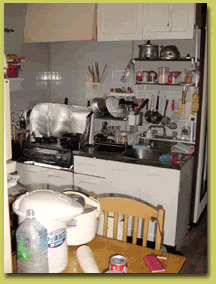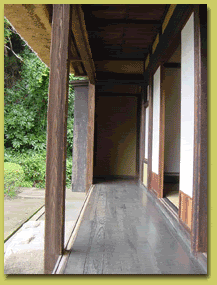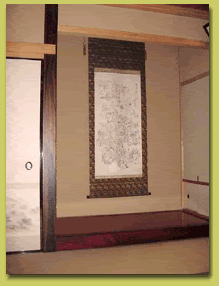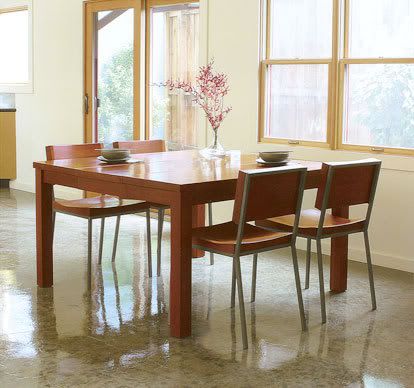 |
Yours Rightfully Insolent
|
|
Posts: 1,946
Join Date: Jan 2007
Location: Happily ever after ^_^
|
|
|
03-31-2007, 06:11 AM
A typical apartment kitchen with rice cooker and hot-water thermos on the table.

An engawa (a veranda or terrace surrounding a house. These come in four types: nure-en [濡れ縁], kure-en [榑縁], kirime-en [切目縁] and takesunoko-en [竹簀の子縁])

Tokonoma (is a small raised alcove in a washitsu, a Japanese style room with a tatami floor, where decorative scrolls are hung. Ikebana (arranged flowers) are also often displayed there) with a hanging scroll.

Japanese dining set

A full buffet done Kyoto style

To get the look:
> Use screens to divide and conceal. There are lots around from the high street to catalogue companies to exclusive oriental shops. Alternatively, make your own from a simple wooden lattice construction. You shouldn't be able to see any nails. In traditional Japanese homes the screens are placed on sliding wooden tracks. Attach and staple gun translucent paper to your wooden frame. Tracing paper will do the trick but might not last that long. Paint the frame black or leave in plain pale wood. Screens can also be made from bamboo and cane. Garden suppliers often have suitable ones.
> Flooring - should be tatami mats. These are best described as half seating, half flooring. You can buy them but they are quite pricey. To imitate the look, buy cheap mats, the sort you get at seaside shops. You could have paper flooring as well. Remember to leave your shoes outside.
> Colour schemes - muted and neutral but with accent colours of red, black, occasionally yellow (this is more Chinese) and the green of sushi. You could paint a whole room in a vermillion red with a lacquered finish - apply lots and lots of varnish or use a specialist paint and work in a well ventilated room.
> All furniture - low-level and kept to a bare minimum. Go for a futon in the bedroom, or just a mattress on the floor. For tables, put low school-type benches either side of the table. Black ash furniture is just right. There is still a lot around thrown out from the 1980s. Also look for lacquered furniture. Real pieces will have beautiful intricate inlays of mother of pearl and gold and silver. Paint your own with a high-varnish spray paint.
> Lighting - very important in the Japanese home. Light is diffused through paper to give a warm glow. Place lights behind your screens to achieve this. You can't go wrong with a simple white paper lampshade. Chinese lanterns are more heavily patterned than Japanese with tassels and calligraphy but you could mix the two looks.
> Traditional Japanese baths are high-sided wooden boxes made from teak, marine ply or cedar wood. If you want one, check whether your floor would need reinforcing. Fake the look with a wooden surround.
> Japanese table settings are very organised. Use bowls rather than plates, with a long runner down the centre of the table. Craquelure ceramics are very Japanese in long slender shapes in greens and black.
> Hang a kimono on the wall as a piece of art. Traditional Japanese ones have a deep blue indigo dye or black and white.
> Display one single spray of orchids, miniature bonsai, pebbles, twigs, and tortured willow. Use fine grey gravel round the top of pots and plants and look for bamboo accessories.
There's no such thing as happy endings, for when you find true love, happiness is everlasting.
Last edited by CoolNard : 03-31-2007 at 09:16 AM.
|